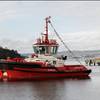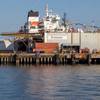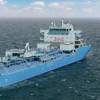World's Largest Cruise Ship Sets Sail, Bringing Concerns About Methane Emissions
The world's largest cruise ship is set for its maiden voyage on Saturday, but environmental groups are concerned that the liquefied natural gas-powered vessel - and other giant cruise liners to follow - will leak harmful methane into the atmosphere.
Royal Caribbean International's Icon of the Seas sets sail from Miami with capacity for 8,000 passengers across 20 decks, taking advantage of the surging popularity of cruises.
The ship is built to run on liquefied natural gas (LNG), which burns more cleanly than traditional marine fuel but poses greater risks for methane emissions. Environmental groups say methane leakage from the ship's engines is an unacceptable risk to the climate because of its short-term harmful effects.
"It's a step in the wrong direction," said Bryan Comer, director of the Marine Program at the International Council on Clean Transportation (ICCT), an environmental policy think tank.
"We would estimate that using LNG as a marine fuel emits over 120% more life-cycle greenhouse gas emissions than marine gas oil," he said.
In terms of warming effects, methane is 80 times worse over 20 years than carbon dioxide, making cutting those emissions key to holding down global temperature warming.
Cruise ships like Icon of the Seas use low-pressure, dual-fuel engines that leak methane into the atmosphere during the combustion process, known as "methane slip," according to industry experts. There are two other engines used on bulk carriers or container ships that emit less methane but they are too tall to fit in a cruise ship.
Royal Caribbean says its new ship is 24% more efficient when it comes to carbon emissions than required by global shipping regulator the International Maritime Organization (IMO).
LNG emits fewer greenhouse gases than very low sulfur fuel oil (VLSFO) that powers most of the global shipping fleet, said Steve Esau, chief operating officer of Sea-LNG, a industry advocacy organization.
Cruise engines convert natural gas into power in a cylinder, where it is "important to make sure that all the natural gas is converted to energy," said Juha Kytölä, director of R&D and Engineering at Wärtsilä, which developed the cruise ship's engines.
What is not converted can escape during the combustion process into the atmosphere, he said, adding that Wärtsilä's natural gas engine technology emits 90% less methane than it did 20 to 30 years ago.
Cruise ship engines have an estimated methane slip of 6.4% on average, according to 2024 research funded by the ICCT and other partners. The IMO assumes methane slip at 3.5%.
"Methane is coming under more scrutiny," said Anna Barford, Canada shipping campaigner at Stand Earth, a nonprofit organization, noting that the IMO last summer said its efforts to cut greenhouse gases includes addressing methane emissions.
Of the 54 ships on order from January 2024 to December 2028, 63% are expected to be powered by LNG, according to the Cruise Line International Association. Currently, about 6% of the 300 cruise ships sailing are fueled by LNG.
Newer cruise ships are being designed to run on traditional marine gas oil, LNG or alternatives like bio-LNG that only account for a fraction of U.S. fuel consumption.
Royal Caribbean will use different fuels as the market evolves, said Nick Rose, the company's vice president of environmental, social, and governance.
"LNG is one piece of our actual strategy," he said.
(Reuters - Reporting by Doyinsola Oladipo in New York; Editing by Mark Porter)













